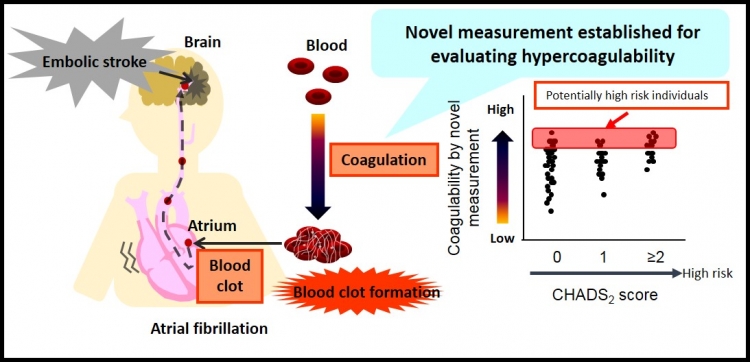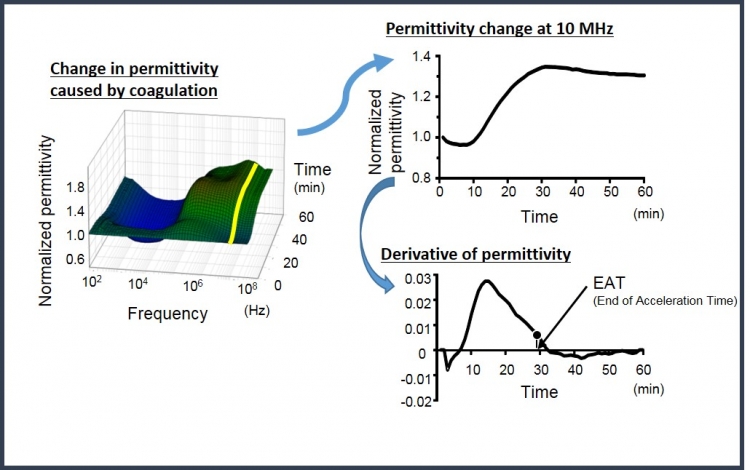“Blood Coagulation Detector May Help in Monitoring Stroke Risk”
Researchers at Tokyo Medical and Dental University (TMDU) show that an analyzer recently developed to measure blood coagulability has the sensitivity to detect hypercoagulatibility associated with stroke risk in those without atrial fibrillation
Tokyo – Atrial fibrillation (AF) causes an irregular and sometimes fast heart rate, and is a common risk factor for stroke. To estimate this risk in AF patients and determine the requirement for anticoagulation therapy, the CHADS2 predictive score is used. Because some parts of this score are also associated with atherosclerosis risk and increased blood coagulability, a high score has been proposed as linked to hypercoagulability (an increased tendency for blood clotting) in both AF and non-AF patients. However, this association has not been fully investigated, partly owing to the lack of a sensitive means of detection.
A research team from TMDU used a highly sensitive technique to measure small changes in blood coagulation, and found hypercoagulability in non-AF patients with high CHADS2 scores. The study was recently reported in PLOS ONE.

Several physical and chemical factors affect blood clotting, some of which can be measured over time to determine blood coagulability and the likelihood of clot formation. Dielectric blood coagulometry (DBCM) is a recently developed test that measures changes in the dielectric permittivity of whole blood, representing clumping of red blood cells. The researchers used DBCM to detect changes in the dielectric permittivity of whole blood at 10 MHz. Comparisons between untreated blood and that with added heparin (a blood thinner) or tissue factor (a blood-clotting accelerator) enabled derivation of a coagulability index.
“We calculated the end of acceleration time (EAT) as an index of coagulability from temporal changes in dielectric permittivity,” coauthor Satomi Hamada says. “This value reduced when tissue factor was added, and increased with heparin present. It was also sensitive enough to detect small changes in coagulability, particularly in hypercoagulability.” EAT also boasts high reproducibility and reliability.

The researchers found that patients receiving warfarin had a significantly longer EAT than those without, confirming the anticoagulation effect. They also showed that patients with a high CHADS2 score had a significantly shorter EAT that represented hypercoagulability compared with patients with lower CHADS2 scores. “Intriguingly, EAT varied widely in patients with CHADS2 scores of 0 or 1,” lead author Yuki Hasegawa says. “This suggests that DBCM can identify high risk of thrombosis even in patients with low CHADS2 scores.”
The article, “Novel dielectric coagulometer identifies hypercoagulability in patients with a high CHADS2 score without atrial fibrillation” was published in PLOS ONE at DOI:10.1371/journal.pone.0156557
Summary
A Tokyo Medical and Dental University (TMDU) research team showed the suitability and sensitivity of dielectric blood coagulometry for identifying hypercoagulability, which is associated with stroke risk, in patients without atrial fibrillation. A novel coagulability index was developed and found to not only correlate with existing CHADS2 scores, but also to offer additional information about thrombosis risk; showing the utility of the new detector for assessing stroke risk both in patients with atrial fibrillation and those without.
Correspondence to:
Department of Biofunctional Informatics,
Graduate School of Health Care Sciences,
Tokyo Medical and Dental University (TMDU)
Phone:+81-3-5803-5365 Fax:+81-3-5803-5365
E-mail: sasano.bi(at)tmd.ac.jp

